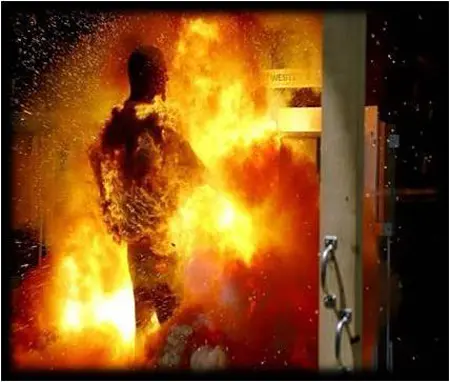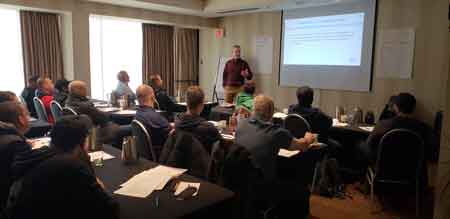480V Arc Flash
By R.W. Hurst, Editor

CSA Z462 Arc Flash Training - Electrical Safety Essentials
Our customized live online or in‑person group training can be delivered to your staff at your location.

- Live Online
- 6 hours Instructor-led
- Group Training Available
Download Our NFPA 70E Fact Sheet – 2024 Electrical Safety Edition

- Understand how NFPA 70E works with NEC and NFPA 70B standards
- Clarify the shared responsibility between employers and employees
- Learn how NFPA 70E supports OSHA compliance
A 480V arc flash is a high-energy electrical explosion that occurs when a fault occurs in a 480-volt system. It can produce intense heat, light, and pressure, leading to serious injuries. Proper personal protective equipment (PPE) and safety protocols are essential to prevent arc flash accidents.
Request a Free Training Quotation
What is "480V Arc Flash"?
A 480V arc flash is a hazardous electrical explosion that occurs when a fault occurs in a 480-volt system.
✅ Can result in severe burns, hearing loss, and equipment damage
✅ Requires PPE and NFPA 70E safety compliance
✅ Common in industrial and commercial power systems
Arc flashes are among the most dangerous incidents in electrical systems, capable of causing severe injuries and significant damage. When dealing with 480V systems, understanding the specific hazards and safety measures is crucial. This article explores the boundaries, contributing factors, required personal protective equipment (PPE), and the thermal intensity of a 480V arc flash, providing essential insights for maintaining safety in electrical environments. For a deeper understanding of what causes arc blast explosions and how they relate to 480V systems, see our page on arc flash blast explosion.
The arc flash (AF) boundary is a critical safety parameter that defines the minimum safe distance from electrical equipment to prevent exposure to the hazardous effects of an arc flash. For 480V systems, the AF boundary varies depending on factors such as the available short circuit current, the clearing time of protective devices, and equipment configuration. Explore our arc flash assessment guide to learn how to evaluate and mitigate 480V arc flash risks.
Determining the exact arc flash boundary for a specific 480V system requires an AF hazard analysis, which calculates the incident energy (the amount of thermal energy released during an AF) at various distances from the equipment. This analysis helps determine the appropriate safety measures, including the required personal protective equipment (PPE).
Electricity Today T&D Magazine Subscribe for FREE

- Timely insights from industry experts
- Practical solutions T&D engineers
- Free access to every issue
Frequently Asked Questions
What is the Boundary for 480V Arc Flash?
The boundary is defined to protect workers from the thermal and physical hazards associated with such incidents. According to NFPA 70E, the AF boundary is the distance at which the incident energy is 1.2 calories per square centimetre (cal/cm²), which is sufficient to cause a second-degree burn. For a typical 480V system, the boundary can vary based on several factors, including the available short-circuit current and the clearing time of the protective devices. Learn about safe working distances in our arc flash boundary guide for 480V electrical systems.
In practice, the boundary for 480V systems is often determined through a detailed incident energy analysis, which considers the specific configuration and conditions of the electrical system. This analysis helps establish a safe working distance, ensuring that workers are adequately protected when performing tasks near energized equipment. Use our arc flash boundary chart to reference safe distances based on incident energy and fault current.
What is the Biggest Factor That Contributes to the Severity?
The biggest factor contributing to the severity of an AF is the incident energy. Incident energy is the amount of energy impressed on a surface at a given distance from the arc source, typically measured in cal/cm². Several factors influence the incident energy, including:
-
Fault Current: Higher available short circuit currents increase the energy released during an AF.
-
Clearing Time: The duration it takes for protective devices to interrupt the fault current significantly impacts the incident energy. Longer clearing times result in higher energy exposure.
-
Voltage Level: The system voltage affects the arc's intensity and the resulting energy. Higher voltages generally produce more severe arc flashes.
Properly managing these factors through system design, maintenance, and protective device settings is crucial for minimizing the risk and severity of arc flashes.
What PPE is Required for 480V?
Personal protective equipment (PPE) is essential for safeguarding workers from the hazards of a 480V arc flash. The required PPE depends on the calculated incident energy at the work site. NFPA 70E categorizes PPE into different levels based on the incident energy exposure:
-
Category 1 (4 cal/cm²): Requires basic protection, including arc-rated long-sleeved shirt and pants or coveralls, face shield, and gloves.
-
Category 2 (8 cal/cm²): Involves wearing an arc-rated suit, hood, gloves, and additional protective gear.
-
Category 3 (25 cal/cm²): Requires an AF suit with a minimum arc rating of 25 cal/cm², including full body protection and headgear.
-
Category 4 (40 cal/cm²): Involves the highest level of protection, including an AF suit with a minimum arc rating of 40 cal/cm² and comprehensive PPE to cover all body parts.
For 480V systems, the specific PPE requirements are determined based on the incident energy analysis, ensuring that workers are adequately protected against the potential hazards. Review the 40 cal arc flash suit requirements if your system analysis shows exposure above 25 cal/cm².
How Hot is a 480V Arc Flash?
The thermal intensity can reach extreme temperatures. The temperature at the point of the arc can be as high as 35,000 degrees Fahrenheit, which is approximately four times hotter than the surface of the sun. This immense heat can cause severe burns, ignite clothing, and melt metal components, leading to significant injuries and damage. Calculate your system’s risk exposure using our arc flash calculator to determine proper PPE and approach boundaries.
The high temperatures are accompanied by other hazardous effects, such as the explosive force of the arc blast, which can propel molten metal and debris at high speeds. The combination of thermal energy and physical force makes arc flashes particularly dangerous, necessitating stringent safety measures and protective gear.
FREE EF Electrical Training Catalog
Download our FREE Electrical Training Catalog and explore a full range of expert-led electrical training courses.

- Live online and in-person courses available
- Real-time instruction with Q&A from industry experts
- Flexible scheduling for your convenience
Understanding the hazards associated with 480V arc flashes is essential for maintaining electrical safety. Key factors such as incident energy, fault current, and clearing time influence the severity of an AF, while proper PPE and adherence to NFPA 70E standards are crucial for protecting workers. By conducting thorough incident energy analyses and implementing appropriate safety measures, workplaces can significantly reduce the risks posed by 480V arc flashes, ensuring a safer environment for all personnel. Discover how to stay compliant with labelling and risk controls by visiting our arc flash analysis and labelling solutions page.
Working with 480V electrical systems requires a thorough understanding of AF hazards and adherence to safety guidelines. By conducting AF hazard analyses, understanding the incident energy, and using appropriate PPE, workers can mitigate the risks associated with AF incidents and ensure a safe working environment. Remember, prioritizing safety is paramount when dealing with electrical hazards, and a proactive approach to AF protection is crucial for preventing injuries and ensuring the well-being of workers.
Related Articles:







